Menu
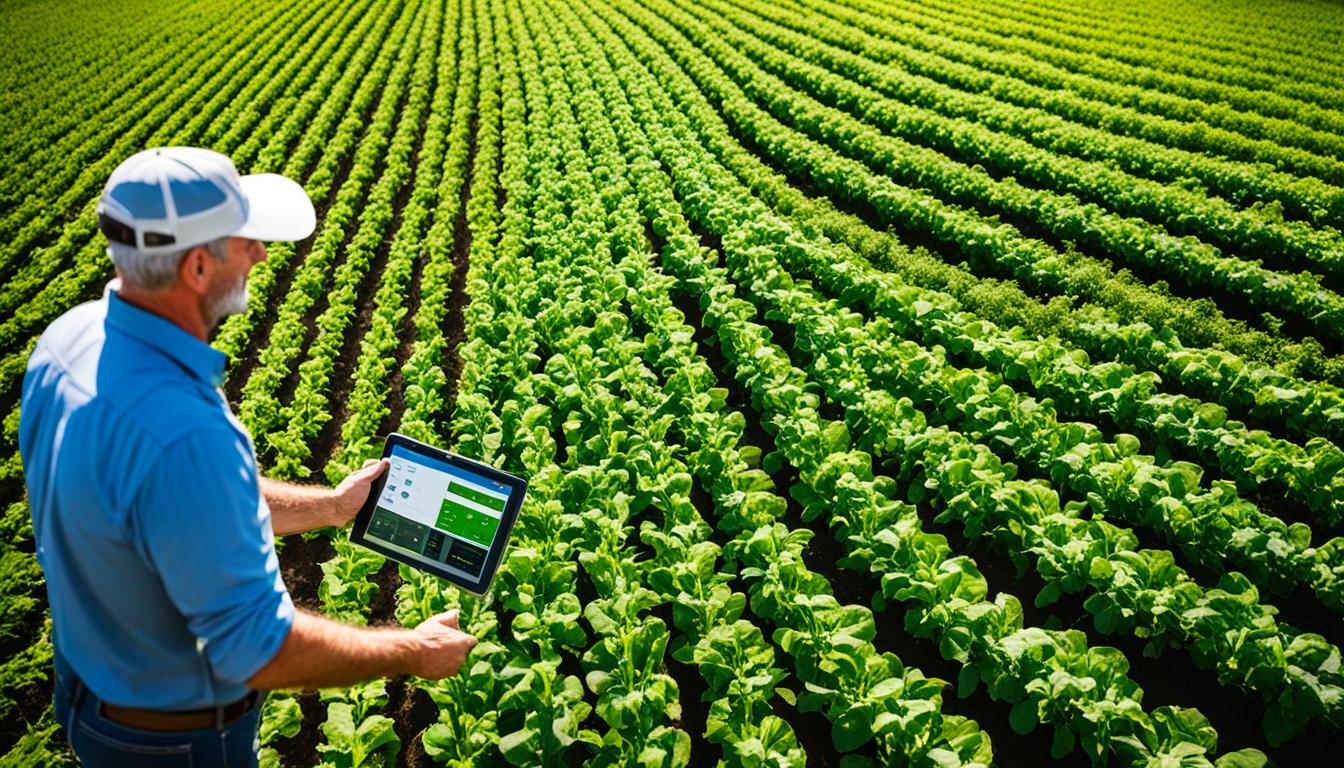
US farming is a big deal, employing 2.6 million people and making nearly $400 billion each year. More than 20% of its products are sold worldwide. But, this success also means farming has a big impact on our planet. It’s linked to about 10% of America’s greenhouse gases.
The demand for food is growing. By 2050, we might need to produce 56% more food than we did in 2010. To meet this demand and protect the Earth, we must farm smarter. This could help cut down on harmful emissions.
Since 1997, farming in the US has become more efficient. The production of crops and livestock has soared by 30%. Yet, the increase in greenhouse gases is much smaller, only 7%. This shows farming can do better for the planet over time.
It’s clear that focusing on how we farm can benefit both food security and the environment. The future depends on finding sustainable ways to grow food.
The agriculture sector plays a major role in global warming, emitting a lot of greenhouse gases. These are mainly methane and nitrous oxide. It’s crucial for this sector to reduce its environmental impact to fight climate change.
Methane and nitrous oxide are the main greenhouse gases from farming. Methane comes from animals’ stomachs and managing their waste. Nitrous oxide releases happen mainly when we use fertilisers and care for soil. These are key in the sector’s emissions.
Agriculture’s emissions come from:
Farming greatly affects the environment, leading to warming and climate change. It’s responsible for a big chunk of global greenhouse gases. If we want to keep our planet cooler, the farming industry has to make serious cuts to its emissions. This also means farming smarter without using more land, and planting more trees.
Agriculture plays a big part in greenhouse gas emissions. This affects climate change and the future of farming. So, it’s vital to manage these emissions.
Ruminants produce high amounts of methane in their stomachs. This happens during digestion and is a major issue. Though, we see hope in feed additives that can lower these emissions. But, their side effects on animals need to be carefully considered.
Manure breakdown also adds to the emission problem. The good news is, we can capture biogas from manure with anaerobic digesters. This turns it into energy and lessens methane releases. Despite their high cost, these digesters are important for reducing greenhouse gases.
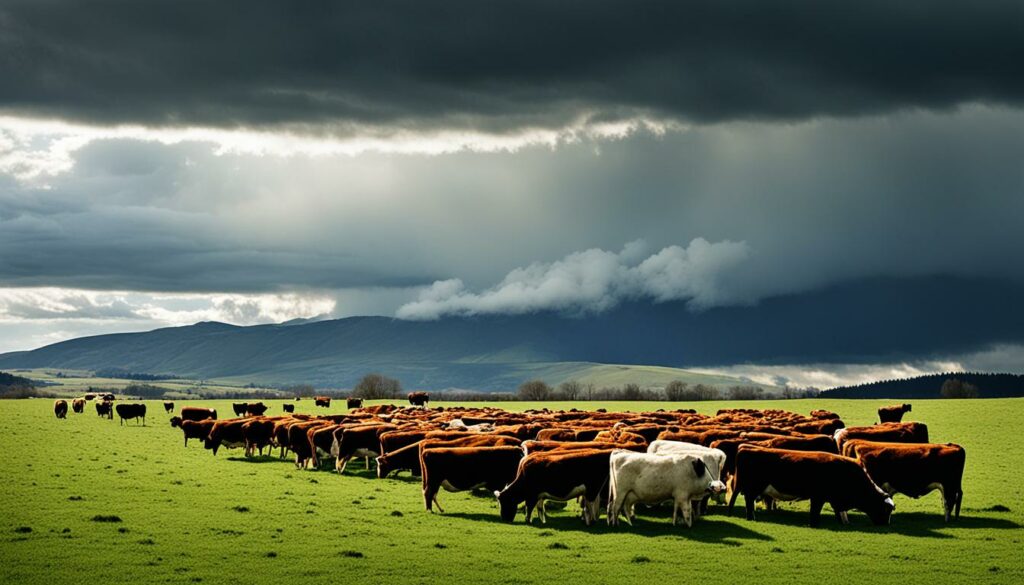
Fertilisers are a big concern due to nitrous oxide emissions. Proper use and timing of these fertilisers can greatly decrease their environmental impact. Using drones to apply fertilisers more accurately is a step towards this.
Cover crops can be used to lower nitrous oxide and help the soil. This approach brings a win-win situation. It makes the use of fertilisers more sustainable.
Soil management is key to reducing emissions. Methods like cover cropping and less tilling increase soil health. This lowers carbon dioxide levels. Some experts, though, debate the direct role of soil disturbance in cutting emissions.
Adopting these soil techniques improves not just emission levels. It also makes soil stronger against climate change. This is vital for long-term agricultural success.
The need to cut greenhouse gas emissions from farming is clear. We must use new technologies to do this. Green farming practices help lower emissions without reducing farm productivity. Innovations in livestock feeding, precision farming, and green fertilisers are leading this effort.
In livestock feeding, we are making big strides. Adding special supplements to feed can cut methane emissions by billions of tons. Techniques to improve how cattle digest food are also key. Grants from the NRCS focus on making livestock feed better and reducing methane.
Farming with precision is a smart way to lower emissions. Technologies like GPS for soil sampling and automatic machines make farming more efficient. This lessens the need for fertilisers, cutting down nitrous oxide. In turn, this improves the overall carbon output of farms.
Creating green fertilisers is an important step. Nitrification inhibitors and fertilisers from renewable sources help reduce emissions. Federal support assists in these efforts. PCSC also injects substantial funds into projects targeting the hefty greenhouse gas contribution of our food system.
Integrating these tech solutions is crucial for eco-friendly farming. Developing livestock, precision agriculture, and greener fertiliser choices is key. They will help agriculture become more sustainable and earth-friendly.
Reducing agricultural emissions is key to fighting climate change. The U.S. agricultural sector released millions of metric tons of CO2 in 2007. This came from activities like soil and manure management. While most emissions are from burning fossil fuels, farming can play a big role in cutting emissions too.
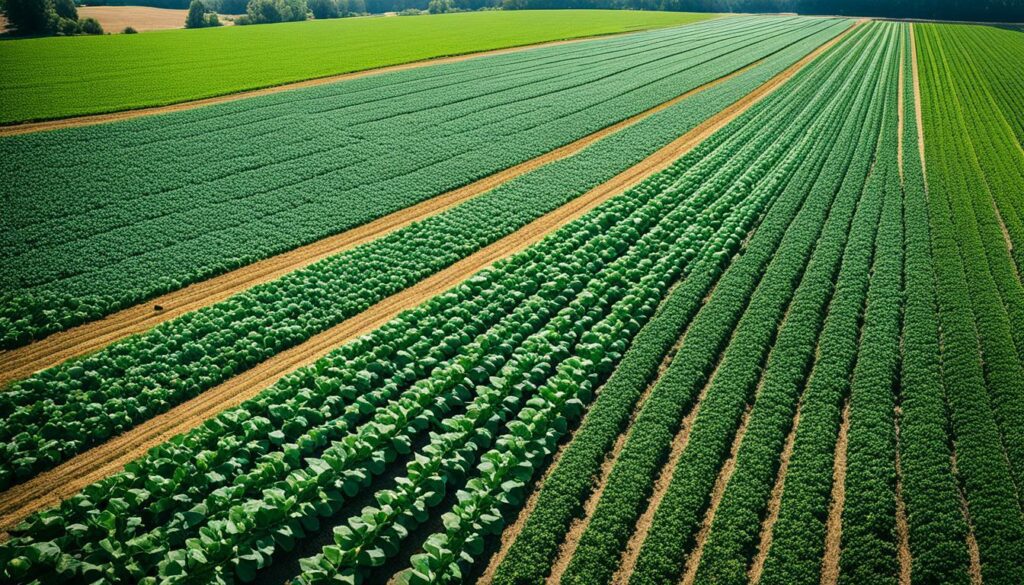
Farmers can help cut emissions by using better practices. They should aim to increase output without needing more land. They can lower methane from animals by changing what they eat and by using digesters. This creates power from the captured methane. Also, using nitrogen better in farming by testing plants and applying it carefully can cut down on harmful nitrogen emissions.
Using conservation tillage, putting in cover crops, and adding more organic matter to soil are all strong ways to keep carbon in the ground. This shift makes farming better for the planet and a big part of fighting climate change.
Systems like cap-and-trade can give farmers credits for lowering emissions. Also, direct supports from the government, like the Conservation Reserve Program, can push farmers to reduce emissions. Programs such as the Renewable Fuel Standard push for renewable energy from farming, such as biofuels, and help cut emissions too.
U.S. farming is big, with millions of workers, and it makes nearly $400 billion a year. It has upped productivity a lot and kept its greenhouse gas emissions nearly steady. This shows farming can really help in the fight against climate change. But, for the planet to stay within safe temperatures, farming and the way we use land must cut emissions by a lot, including stopping deforestation by farming.
In the search for a green future in agriculture, it’s vital to use earth-friendly farming methods. These not only cut the sector’s carbon footprint but also boost farm resilience and yield. Conservation agriculture includes techniques like conservation tillage, agroforestry, and crop rotation with cover crops.
Conservation tillage is key in conservation agriculture. It cuts down on soil disturbance, saving soil structure and organic matter. This lessens erosion and runoff, helping to cut soil’s carbon dioxide release. Keeping soil covered with crop residue also boosts biodiversity and health.
Agroforestry mixes trees and shrubs into farming landscapes, bringing many benefits. It improves carbon sequestration, thus lowering greenhouse gas emissions. Trees shield against wind, prevent soil erosion, and add homes for wildlife. Also, it helps the soil retain water, making crops more resistant to extreme weather.
Crop rotation and cover cropping are crucial for nutrient-rich soil without the need for many chemicals. Alternating crops helps break pest cycles, lessening pesticide use. Using plants like legumes for cover adds natural nitrogen to the soil, reducing the use of chemical fertilizers.
These steps are also critical in stopping soil erosion and keeping it moist for good crops. They highlight the power of sustainable agriculture methods in turning farming into a green and profitable field. By saving resources and boosting land productivity, they are key to a sustainable farming future.
Exploring carbon sequestration in farming means looking at ways to capture CO2 and help the climate. One such way is storing carbon in the soil. Over the last 12,000 years, 133 billion metric tons of CO2 came from soil into the air. This is more than what all human activities did in 2019.
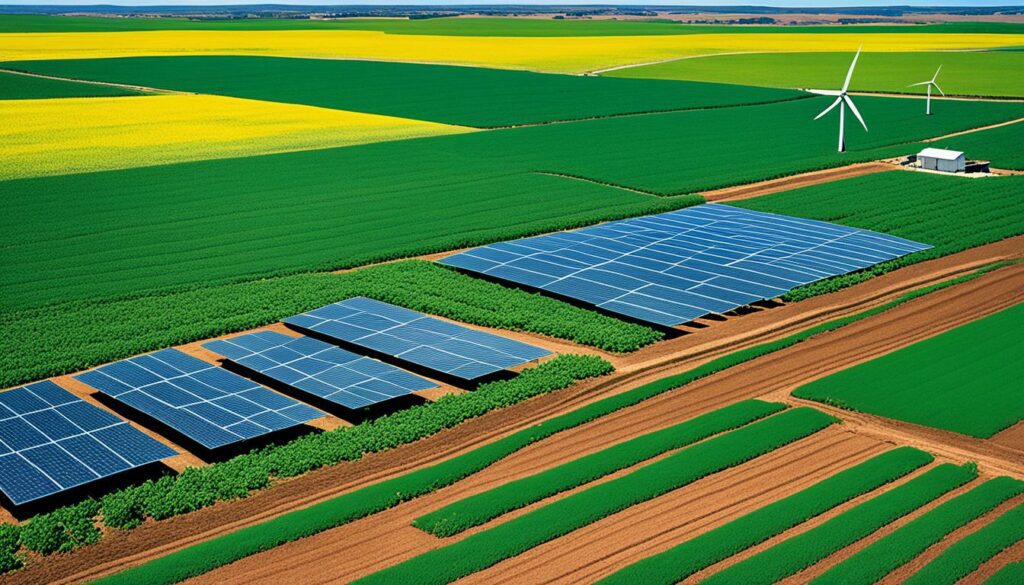
In some farmlands, up to 70% of the organic carbon in the soil is now gone. By 2030, storing carbon in soils globally could cut off up to 5.3 GtCO2 emissions each year. This is close to what agriculture yearly emits, yet applying these methods has a cost. The IPCC says it costs about US$100 to store a ton of CO2. For many farmers, this cost might be too high.
Investors often buy carbon credits for $15–$20 per metric ton in voluntary markets to reduce their emissions. But these low prices make it hard for farmers to profit from such methods. Almost 40% of U.S. farmland is rented, which could limit many farmers from using these carbon markets.
The Growing Climate Solutions Act helps remove obstacles for farmers in carbon markets. It provides support in both selling and making carbon credits. The USDA is also making the CRP better, offering more incentives to store carbon in soils.
Under President Biden, the USDA is putting $300 million to better manage greenhouse gases and carbon storage in farming and forestry. This shows a big push to make agriculture play a bigger role in fighting climate change. Plus, the Inflation Reduction Act is putting nearly $20 billion over five years into key USDA conservation work. The USDA saw three times the usual demand for funding, showing a huge interest in these carbon storage methods.
| Statistical Context | Carbon Sequestration Potential |
|---|---|
| CO2 Released from Soil (in past 12,000 years) | 133 billion metric tons |
| Annual Global Soil Carbon Sequestration (Potential by 2030) | 5.3 GtCO2 |
| Annual Agriculture Emissions (2000–2010) | 5.0–5.8 GtCO2-eq |
| Cost to Implement Technologies (per ton of CO2) | ~US$100 |
| Price per Ton of Carbon in Voluntary Markets | $15–$20 |
Enhanced soil management is key to making agriculture more eco-friendly. It does so by improving soil health and storing more carbon. One way to do this is through no-till farming. This method lets farmers trap more carbon in the soil and cut down on harmful emissions.
Conservation cover is also vital for soil health. It helps capture more carbon, clean water, and create homes for wildlife. Another helpful method is rotating crops. This can increase carbon storage, make water cleaner, and decrease pests.
Next, filter strips and mulching play big parts. Filter strips catch more carbon and stop nitrogen from water pollution, which cuts down nitrous oxide emissions. Mulching keeps the soil healthy by saving moisture, stopping erosion, and supporting plant growth.
Stripcropping mixes several benefits for sustainable soil management. It stores more carbon, lessens soil erosion, and improves water quality. Pairing livestock and crops can reduce methane emissions. This is done by managing animal waste better.
Anaerobic digesters are another boost for soil care. They cut down greenhouse gases, control smells, and make electricity. Lastly, managing nutrients smartly is a must. It makes air and water cleaner, boosts plant growth, and saves on costs.
| Technique | Benefits |
|---|---|
| No-Till Practices | Increase soil carbon sequestration, reduce emissions |
| Conservation Cover | Improve soil health, carbon sequestration, water quality |
| Conservation Crop Rotation | Increase carbon sequestration, improve water quality, reduce pests |
| Filter Strips | Increase soil carbon sequestration, prevent nitrogen pollution |
| Mulching Techniques | Increase soil carbon sequestration, improve moisture management, limit erosion |
| Stripcropping | Increase soil carbon sequestration, reduce erosion, improve water quality |
| Livestock Partnerships | Reduce methane emissions, support climate change mitigation |
| Anaerobic Digesters | Reduce greenhouse gas emissions, manage odours, reduce pathogens, generate electricity |
| Nutrient Management Practices | Reduce nitrous oxide emissions, enhance plant health, improve water quality, lower input costs |
By using these methods, we can make farming more climate-friendly. Agriculture can then help fight climate change and become more resilient.
Policymakers know that farming is crucial for fighting climate change. More than a quarter of the world’s greenhouse gases come from farming, forestry, and land use. So, coordinated farming policies are needed to lower this impact.
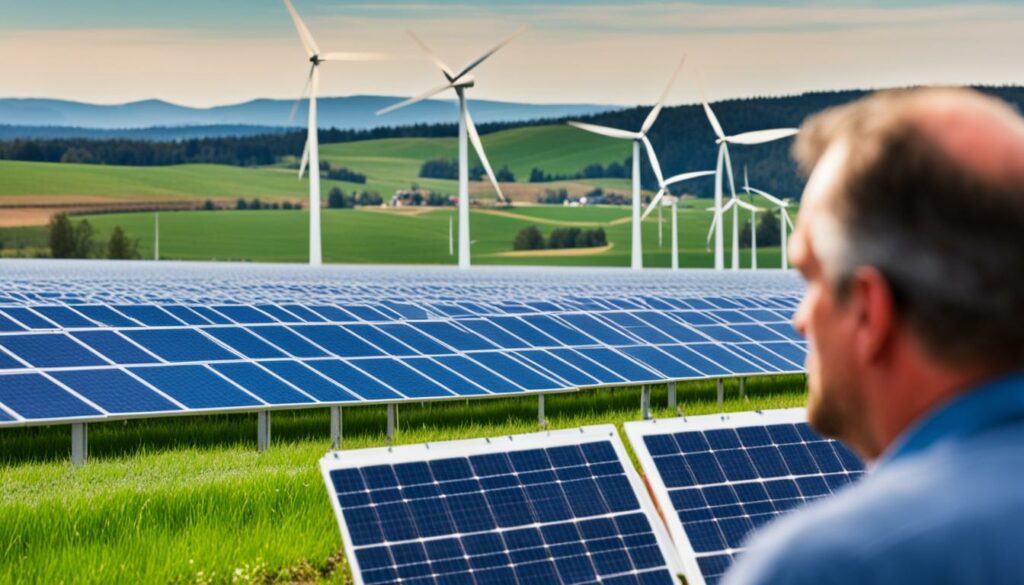
The push to keep climate change below 1.5 degrees is big and fast. Certain farming methods can cut about 20 percent of emissions by 2050. These methods must be supported by policies for our climate goals to work.
Agricultural policies give farmers reasons to act on climate change through laws. For example, the Emissions Reduction Fund helps farmers lower their emissions and get paid for it. This encourages farmers to use eco-friendly ways.
Policies also encourage using more renewable energy on farms. With help from groups like the Australian Renewable Energy Agency (ARENA), farmers can get funding for solar panels and bioenergy. This helps them reduce their environmental impact.
The Australian Bureau of Agricultural and Resource Economics and Sciences (ABARES) does research on climate change. This helps make farming policies more effective in protecting our climate. Their work links agricultural policies with big climate action plans.
Now, let’s look at some key policies for cutting emissions in farming:
| Measure | Impact | Potential Reduction (GtCO2e by 2050) |
|---|---|---|
| GHG-efficient farming technologies | 20% of sector’s reduction required | Comparable to top 25 measures |
| Carbon offsets | Enables transition to sustainable practices | 4.6 |
| Renewable energy investments | Reduces energy-related emissions | Significant; part of the top 15 measures |
In summary, smart farming policies, laws on climate change, and rewards for reducing emissions are key to cutting down farm emissions. These efforts not only push for more eco-friendly farming but also make sure farms can last in a changing climate.
Farmers are being urged to adopt eco-friendly practices through various schemes. Making sure these schemes are both easy to get to and helpful is key to cutting down on farm emissions. Let’s take a look at the different ways governments, private companies, and global groups are supporting this.
Government projects like the EQIP give big incentives to farmers. EQIP supports with money and advice to fix environmental issues. This includes making water, soil, and air better, helping wildlife, and fighting climate change. Programs like High Tunnel and Organic Initiatives push for more eco-friendly farming too.
Private businesses are also helping farmers in big ways. They fund new projects and push for the use of green tech. For example, the Conservation Innovation Grants assist in new ways to care for the land. This shows how important private help is for making farming more sustainable.
Worldwide, global frameworks are joining hands for eco-friendly farming. Efforts such as the Climate-Smart Commodities Mission, backed by the USDA, make a massive impact. They’ve invested billions to help over 50,000 farms worldwide. These projects focus on capturing carbon in the soil and aim for big positive effects on our planet.
| Programme | Focus Areas | Benefits |
|---|---|---|
| EQIP | Water and air quality, soil health, wildlife habitat | Reduces contamination, implements climate-smart practices |
| High Tunnel Initiative | Extended growing season | Optimises crop production and quality |
| Organic Initiative | Support for organic operations | Enhances organic farming techniques |
| Conservation Innovation Grants | Innovative approaches | Stimulates conservation adoption |
| Partnerships for Climate-Smart Commodities | Carbon sequestration, market expansion | Reduces greenhouse gas emissions, expands market opportunities |
Altogether, these numerous incentives from governments, private groups, and global effortsare making a big difference in encouraging sustainable farming.
Study of successful emission cuts in farming around the globe is enlightening. It shows how smart farming and acting against climate change lead to good results. It proves we can make a big difference with the right steps.
America has made big strides in cutting farm emissions and raising yields. Using AWD in growing rice, methane was cut by half and water usage by 30%. The use of UDP in Bangladesh has had a similar effect on a large scale. These methods show that wide use can lead to big cuts in emissions, as hoped by the AAPI.
The EU leads with its efforts to fight climate change in farming. It funds carbon farming and involves the food industry in cutting emissions. Private firms are using forests sustainably too. They look at tree cover to gauge forest health, a key part in reducing emissions.

Developing nations also shine in creating green ways to farm. In Zambia, a new farming method has lifted crop yields and trapped carbon. In Kenya, cutting animal numbers has curbed emissions from farming. Grasslands in Ethiopia are also trapping more carbon. Plus, 119 countries have stepped up by including farming in their climate plans, showing a united front against climate change.
| Region | Innovative Practice | Impact |
|---|---|---|
| United States | Alternate Wetting and Drying (AWD) | Reduces methane emissions by up to 50%, water use by up to 30% |
| Bangladesh | Urea Deep Placement (UDP) | Significant emission reductions with wide uptake |
| Zambia | Alley Agroforestry | Increased crop productivity, carbon sequestration |
| Kenya | Herd Reduction Project | Reduced livestock emissions |
| Ethiopia | Grassland Improvements | Increased biomass, soil carbon sequestration |
Moving towards green farming isn’t easy. There are many challenges farmers and policymakers face. One major challenge is adapting to new technology. A lot of farmers don’t have the know-how or money to switch to lower-GHG practices. This is made worse by social and behaviour issues, as shown by Barham et al. (2014).
Policy implementation is also hard. It involves dealing with measurement and baseline uncertainties. Programs like CRP, CSP, and EQIP help with money and tech advice. But, these schemes often don’t directly reward farmers for lowering GHG emissions. So, they might not see the point of big changes.
The fact that USDA programmes are voluntary reduces their impact. Farmers might not join in if they won’t see quick benefits. Introducing new methods can sometimes cut cost savings, which reduces the reason for trying these programs.
Also, there are climate-smart programmes that push for ‘greener’ goods. These can attract eco-minded buyers. But, selling GHG emission credits needs a strong setup. This system must be good for both sellers and buyers of these credits.
Small and disadvantaged farmers face more obstacles. For them, getting into the GHG credits market might need initial help. Supporting these farmers is important for global land use, which affects everyone.
In places like sub-Saharan Africa, better irrigation is key, along with using less chemical fertiliser. We need to protect the environment from these harmful chemicals.
“Currently feasible reductions, even with a global agricultural emission price of US$20/tCO2-eq, would deliver only 0.2–0.4 GtCO2-eq abatement by 2030.”
To tackle these problems, we need a mix of new policies, more education, money incentives, and tech help. These steps can really help farmers go green.
Sustainable agriculture offers many benefits. It improves the economy, helps the environment, and supports society. I’ll discuss how sustainable farming practices impact the U.S. agriculture sector broadly.
Advantages of sustainable farming include economical benefits. The U.S. agriculture sector, with 2.6 million workers, makes nearly $400 billion every year. It saves money by using resources better and growing crops more effectively. For example, using fertilisers carefully and using fewer pesticides can save money and boost productivity.
There’s also a greater demand for sustainable products globally. This opens new markets and boosts economic growth.
Sustainable agriculture benefits the planet. It helps fight climate change by reducing greenhouse gas emissions. For instance, techniques like conservation tillage and agroforestry lock away carbon. They also help prevent soil erosion and lower water pollution.
This all adds up to a significant cut in the sector’s carbon emissions. It supports the global aim to limit warming to 2 degrees C by 2050.
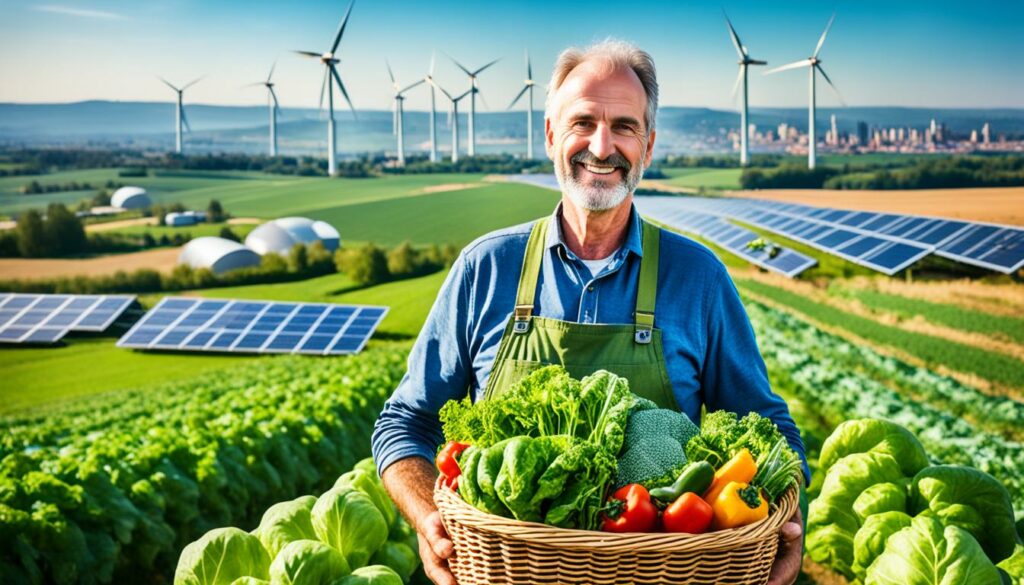
But the good effects aren’t just seen in the economy and the environment. Sustainable farming helps create jobs and supports rural areas. It also makes sure we have enough healthy food for the growing population.
This leads to better health for the public too. These methods strengthen the community and make it more self-sufficient.
To sum up, sustainable agriculture has a wide range of benefits. It helps the economy, the environment, and society. It plays a crucial part in securing a sustainable future for the U.S. agriculture sector.
The future of farming must tie closely to climate-friendly ways. We face big challenges, like meeting the food needs of 9.7 billion people by 2050. At the same time, we must tackle issues like methane emissions and water use.
It’s crucial to make agriculture climate-resilient. The farming sector globally creates a third of all emissions. And, if food waste was a country, it would rank as the third-largest emitter. Sustainable farming is getting more attention.
Investments and new policies are driving this shift. For example, only 4% of climate finance goes to the agrifood sector. This money mainly supports small farmers. The focus is on making agriculture both productive and eco-friendly.
Reforming policies is key to promoting sustainability. The World Bank is upping its investments to more than $3 billion a year for climate-smart farming. This aids in bringing gender-friendly and advance green practices to all farming areas.
The World Bank is working on a big project in Jordan. They’re helping 30,000 households use better water and climate methods over five years. Also, by choosing eco-farming, over 8.8 million tons of carbon extra store up in the soil each year.
The U.S. Department of Agriculture (USDA) is also making a big push for green farming. They’re investing almost $2.8 billion to encourage climate-friendly projects. With a soaring demand, their budget grew from $1 billion to over $3 billion.
| Entity | Investment | Initiative | Impact |
|---|---|---|---|
| World Bank | $3 billion annually | Climate-Smart Agriculture | Supports 30,000 farming households |
| USDA | $2.8 billion | 70 agriculture projects | Sequesters 50 million metric tons of CO2 equivalent |
| USDA and NRCS | $50 million | 118 partnerships | Expand conservation assistance |
The USDA’s work doesn’t stop at big projects. They also fund smaller efforts, like a $10 million project across ten states. Plus, $330 million supports local programs. Together, these programmes are shaping a future of farming with less pollution and more carbon sequestration.
Sustainable agriculture is crucial in the fight against climate change. The farming industry both creates and reduces harmful gases. Through smart methods, we can cut down these emissions a lot.
Tackling the future means making food without making the Earth suffer. Changing what animals eat and how we fertilise fields can help a great deal. Countering the farming carbon footprint is possible by these means.
Farming can also absorb carbon. Methods like no plow farming, adding crops between seasons, and using more natural material in soil can help. Government plans that support clean fuel and farming with less harm are in place too.
A new limit on emissions, with rewards for cleaner farm work, is on the horizon. These changes will not only help the environment but also make farming better. That way, the world can hope to be free of climate damage by 2050. It will take new tech, rules, and a new way of thinking to get there.
Agriculture makes a lot of methane and nitrous oxide. These gases warm the Earth’s atmosphere.
The main causes are from keeping livestock and using fertilisers. These include the gas from the stomachs of animals and chemicals in the soil.
These emissions make the air hold more heat. This leads to a warmer climate worldwide.
Using better feed and additives can help. Also, managing animal waste better is key to cut back emissions.
You can use things like nitrification inhibitors. Also, getting fertilisers from renewable sources and using them carefully is good.
It’s about using modern tools to grow crops more efficiently. This helps in using only what’s needed and not wasting resources. Tools include soil scanners, GPS, and analysing data.
Techniques like not ploughing the land too much, planting trees with crops, and changing what you grow each season are great. They help the land stay healthy, produce more, trap carbon, and lower gas levels.
It’s about capturing carbon in the soil and plants to lower harmful gas levels. This can balance out some of the bad effects of farming on the environment.
By doing things like planting cover crops or changing how you dig the land, you can make the soil better. This traps more carbon and reduces the gases warming our planet.
There are rules to help, like paying for good farming that helps the climate. Also, these rules encourage using clean energy on farms.
Farmers can get help from the government, businesses, and global plans. They offer money, help with studies, and support to try better ways of farming.
Some good actions are making more food without needing more land, using smart methods to feed livestock, and being careful with fertilisers. The U.S., the EU, and other places show they work.
Big change is hard because it needs new ways of farming. Money and the will to try something different are challenges too. But, by helping farmers learn and making it worth their while, we can overcome these.
This kind of farming saves money, makes more food, keeps the land healthy, and supports communities. It’s good for everyone and for the planet.
We think farming will become much greener in the years to come. This will be because of new rules and people asking for food made in ways that protect the planet. It’s a must to fight hunger and climate change.